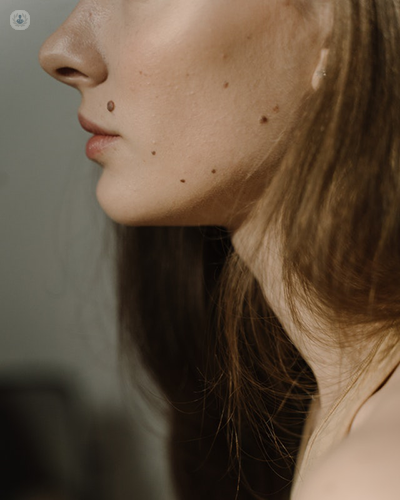Lumps, bumps and growths: What to expect from skin lesion removal
Escrito por:Skin lesions, which can include lumps, bumps or moles, sometimes need to be removed if the growth is cancerous or is suspected to be so. In other cases, the location of the growth may be causing discomfort or patients may be bothered by the physical appearance of the lesion. Whatever the reason for removal, skin lesion procedures are usually quick and painless. In this article, highly respected general surgeon Mr Philip Ridings explains what patients can expect from the procedure as well as offering expert insight on the most common types of skin lesions.

What is a skin lesion? When do skin lesions need to be removed?
A skin lesion can be a pigmented or coloured spot on the skin which are commonly known as moles. Sometimes we need to remove them if they have changed in colour or size.
Other types of skin lesions are lumps that you can feel in or just under the skin. The most common types of these are sebaceous cysts, little blocked oil or sweat glands, and fatty lumps, an overgrowth of normal fat cells. These types of skin lesions are not harmful but if they are found in a prominent place, such as the forearm, they can often be knocked or brushed against, making them tender and painful. For that reason and also because they can be unsightly, patients sometimes wish for them to be removed.
Most skin lesions are not harmful but occasionally moles can be cancerous. They may need to be removed to determine whether they are cancerous or benign (non-cancerous). Sebaceous cysts can get infected from time to time and in this case, they are often removed.
How are skin lesions removed?
The vast majority of skin lesions are removed under a local anaesthetic, given by injection under the skin around the lesion. It’s quite painless apart from the first few seconds when it can sting, then everything goes numb and following that you should feel no pain whatsoever. Some patients do feel slight pressure sensations, however.
We usually make a single incision over the lump and then remove it, suturing the defect closed with dissolving stitches so there’s no need to return for stitch removal. We usually send off the lesion after it is removed to the lab to make sure that it is completely benign and harmless and to reassure that no further action is required.
Is skin lesion removal safe?
The risks of removing a skin lesion are very small. Wound infections can occur in any surgery but these are extremely uncommon in this type of procedure as it is a clean surgery which is done under sterile conditions.
How long does the procedure take?
The majority of skin lesion removals are done in outpatient clinic. Patients find the procedure very quick and simple: they usually walk in, undergo the procedure and then walk out in a relatively short amount of time.
After the procedure is complete, the patient relaxes with a cup of tea or coffee for around fifteen minutes just so we can check they are feeling alright before leaving. The local anaesthetic will wear off after about an hour. Most patients don’t require any further pain relief but some may want to take paracetamol for a day or so after the procedure.
How can patients prepare before a skin lesion removal?
In terms of preparation, patients will have seen a consultant beforehand who will describe the plan of action and will organise an appointment at the minor operations room at the local hospital. Before the procedure, there’s no need to fast or avoid fluids.
Can skin lesion removal result in scarring?
Afterwards, the scar can occasionally can become itchy and irritable but that should settle after a couple of weeks.
There is a condition called keloid scarring where you get an overgrowth of the scar tissue which can be unsightly. If that occurs, the patient would need to return for a follow up, where we would give some steroid cream or a local injection of steroids to reduce the over-healing. However, this is extremely uncommon but can occur if the lesion is in the midline, perhaps over the breast bone or in the head and neck area.
For the vast majority of patients however, the wound heals very nicely and nothing more needs doing apart from the reassurance that all is well.
If you are seeking treatment for a skin lesion or would like more information, don’t hesitate to visit Mr Riding’s Top Doctors profile.


